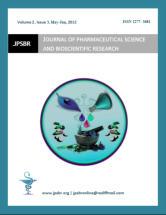





ISSN 2277 - 3681
Volume 2, Issue 3
Pages no. 97-161
Available online 13 June 2012
Bring your pointer on Abstract to show abstracts




Formulation and In-Vitro Evaluation of Captopril Floating Matrix Tablets using HPMC 50cps
Basawaraj S.Patil*, Sandeep J. Sonawane, Upendra Kulkarni, Hariprasanna R.C.




Design and Development of Multi-Application Lornoxicam Fast Dissolving Tablets by Novel Drug - Drug Solid
Dispersion Technique with Ranitidine
Upendra kulkarni*, N.G.Raghavendra Rao




Formulation and Development of Fast Disintigrating Tablets using Cimetidine as A Model Drug
Nihar Shah, Nishith Patel, Dipen Patel, Dr. Kanubhai R. Patel




RP-HPLC Method for Simultaneous Estimation of Artesunate and Amodiaquine HCL in their Combined
Pharmaceutical Dosage Form
Odedara M.H*, Faldu S.D, Dadhania K.P.
Q-Absorbance Ratio Spectrophotometric Method for the Simultaneous Estimation of Ciprofloxacin and
Metronidazole in their Combined Dosage Form
Nikita V. Patel* , Arun M. Prajapati







A Review on Gastroretentive Drug Delivery System
Pranav Joshi*, Priyank Patel, Hiren Modi, Dr.M.R. Patel, Dr.K.R.Patel Dr.N.M.Patel




RP-HPLC Method for Simultaneous Estimation of Simvastatin and Coenzyme Q10 in their Combined Formulated
Dosage Form
Patel Mahendra A*, Hiren K Kadiker









UV-Spectrophotometric Determination for Simultaneous Estimation of Amlodipine Besylate and Telmisartan in
Combination
K. P. Hirpara *, Dave V. M., Dr. S. D. Faldu, Dr. B. D.Patel
Development and Validation of RP-HPLC Method for Simultaneous Estimation of Cefepime Hydrochloride and
Amikacin Sulphate in Injection Dosage Form
Dave Vimal M*








Development and Validation of RP-HPLC Method for Simultaneous Estimation of Furosemide and Spironolactone
in their Combined Tablet Dosage Form
Bhojani Maulik*, Dadhania Ketan, Faldu Shital
Design of a buccal mucoadhesive, nanoparticles based delivery system of fluoxetine
Abhay S. Sapre * and Rajesh K.Parikh


© JPSBR Publications 2011-2024
Powered by Opus
ABSTRACT
In the present investigation a gas powered tablets
(
floating tablets)
of Captopril were prepared to increase
the gastric retention time in order to improve the therapeutic effect of the drug by increasing its bioavailability.
Captopril is antihypertensive drug, it is soluble in water; its maximum absorption is from the stomach and upper
part of the intestine.
The Gas powered tablets were prepared by direct compression method.
A present
investigation
comprises a drug Captopril, a gas generating agent
6 to 18% sodium bicarbonate
, water soluble
polymers
40 to 60% HPMC 50 cps
to get the desired controlled release over a period of 10 hrs. The prepare
d
tablets were subjected to post-compressional parameters such as hardness, friability, weight variation, thickness,
drug content, lag time subsequently buoyancy time, and
in-vitro
dissolution studies. Drug compatibility with
excipients was checked by FTIR and DSC studies. The formulations C3 was found to be promising, which shows an
in vitro
drug release of 91.32% in 10 hrs along with satisfactory floating lag time (2 min.27 sec.). All the
formulations exhibited diffusion dominated drug release.
KEYWORDS
: Captopril, HPMC 50 cps, gastro-retentive floating drug delivery systems, hydro dynamically balanced
systems.
ABSTRACT
In the present research investigation, the effect of a novel- drug-drug solid dispersion approach on the dissolution
of insoluble Lornoxicam (LOR) with soluble Ranitidine (RAN) was studied. Solid dispersion of LOR with RAN (8:150)
was prepared by solvent evaporation technique. Solid dispersions were characterized by FTIR study. Solid
dispersions were then compressed into fast dissolving tablets (FDTs) and evaluated for quality control tests. Long-
tern treatment with NSAIDs may produce gastrointestinal symptoms for which histamine H
2
-receptor antagonists
may be prescribed. Thus, there is a need for a formulation that is not only providing improvement in solubility but
at the same time reduces GI adverse effects of Lor. The solubility of Lor was increased in solid dispersion as
observed from phase solubility study. Pharmacological studies on LOR FDTs were carried out in rats for establishing
its gastric tolerance relative to marketed tablet (MT) containing 8 mg lornoxicam. MT caused significant gastric
damage, our novel Lor FDTs at equimolar dose did not cause any GI damage. This gastric-sparing effect could be
attributed to the beneficial action of RAN present in the formulation.
KEYWORDS
: Lornoxicam, Ranitidine, drug-drug solid dispersion.
ABSTRACT
The present study was aimed towards the formulation and eveluation of fast disintegrating tablets by direct
compression technology using Cimetidine as a model drug. Fast disintegrating tablet of Cimetidine was formulated
using three Superdisintegrates in different concentrations i.e. 4%w/w, 6%w/w and 8%w/w and one disintegrates
having concentration i.e. 4%w/w, 6%w/w and 8%w/w like Cross carmellose sodium, Crospovidone, Sodium Starch
Glycolate. All the batches were prepared by direct compression method using the Cadmach Single punch tablet
compression machine using 14X32 mm flat punch. Disintegration time and drug release were taken as the basis to
optimize the immediate release tablet. Prepared tablets were evaluated for thickness, hardness, friability,
uniformity of weight, disintegration time, wetting time and dissolution study Selected formulation was subjected
to stability studies for thirty days which showed stability with regards to release pattern.
KEYWORDS:
Fast Disintegrating Tablet, Cimetidine, Superdisintegrants, Direct Compression Technology
ABSTRACT
A Simple, precise, accurate and rapid RP-HPLC method developed and validated for the simultaneous estimation
of Artesunate and Amodiaquine HCl in pure and pharmaceutical dosage form. The quantification was carried out
using symmetry C
18
column, 250 x 4.6 mm, i.d, 5μm particle size in isocratic mode, with mobile phase compressing
of buffer and methanol in the ratio of 30:70 (v/v), pH 3 ± 0.5. The flow rate was 1 ml/min and the detection was
carried out by UV detector dual i.e, 225 and 339 nm. The retention times were 2.39 and 3.99 mins for Amodiaquine
HCl and Artesunate, respectively. The percentage recovery was found to be 99.40 and 99.83 % for Amodiaquine
HCl and Artesunate, respectively. The method was validated as per ICH guideline.
KEYWORDS: HPLC system, Amodiaquine HCl and Artesunate , UV detector.
ABSTRACT
The present manuscript describes simple, sensitive, rapid, accurate, precise and economical Q-
absorbance ratio method for the simultaneous determination of Ciprofloxacin and Metronidazole in
combined dosage form. Absorbance ratio method uses the ratio of absorbances at two selected
wavelengths, one which is an isoabsorptive point and other being the λ-max of one of the two components.
Ciprofloxacin and Metronidazole show an isoabsorptive point at 295 nm in methanol. The second
wavelength used is 279 nm, which is the λ-max of Ciprofloxacin in methanol. The linearity was obtained in
the concentration range of 2-10 μg/ml for Ciprofloxacin and Metronidazole. The concentrations of the drugs
were determined by using ratio of absorbances at isoabsorptive point and at the λ-max of Ciprofloxacin.
The method was successfully applied to pharmaceutical dosage form because no interference. The results
of analysis have been validated statistically and by recovery studies.
KEY WORDS:
Ciprofloxacin, Metronidazole, absorbance ratio method, isoabsorptive point, validation,
simultaneous.
ABSTRACT
Gastroretentive
drug
delivery
system
comprised
mainly
of
floating,
bioadhesive,
swelling,
high
density
and
magnetic
systems
have
emerged
as
a
current
approaches
of
enhancing
the
bioavailability
and
controlled
delivery
of
drugs
that
exhibit
an
absorption
window.
By
prolonging
the
gastric
emptying
time
of
the
dosage
form,
these
systems
not
only
provide
controlled
release
of
the
drug
for
a
prolonged
period
but
also
present
the
drug
in
an
absorbable
form
at
regions
of
optimal
absorption.
CR-GRDF
provides
a
means
to
utilize
all
the
pharmacokinetic
(PK)
and
pharmacodynamic
(PD)
advantages
of
controlled
release
dosage
forms
for
such
drugs.
Due
to
the
complexity
of
pharmacokinetic
and
pharmacodynamic
parameters,
in
vivo
studies
are
required
to
establish
the
optimal
dosage
form
for
a
specific
drug.
For
a
certain
drug,
interplay
of
its
pharmacokinetic
and
pharmacodynamic
parameters
will
determine
the
effectiveness
and
benefits
of
the
CRGRDF compared to the other dosage forms.
KEYWORDS:
floating, bioadhesive, swelling, high density and magnetic systems
ABSTRACT
A Simple, precise, accurate and rapid RP-HPLC method developed and validated for the simultaneous estimation
of Simvastatin and Coenzyme Q10 in pure and formulated dosage form. The quantification was carried out using
symmetry C
18
column, 250 x 4 mm, i.d, 5μm particle size in isocratic mode, with mobile phase compressing of
Acetonitrile and Tetrahydrofuran (80:20). The flow rate was 1 ml/min and the detection was carried out by UV
detector 254nm. The retention times were 6.47 and 3.64 min for Coenzyme Q10 and Simvastatin, respectively.
Percentage recovery for SIM was 98.72-101.45%
,
while for COQ10, it was found to be in range of 98.00-101.27%.
The method was validated as per ICH guideline.
KEYWORDS: HPLC system, Coenzyme Q10 and Simvastatin , UV detector.
ABSTRACT:
Two simple spectrophotometric methods have been developed for simultaneous determination of Amlodipine
besylate and Telmisartan in tablet formulation. Method 1 is Absorbance correction method, which is based on
determination of Amlodipine besylate at 362 nm using its absorptivity value and Telmisartan at 292 nm. Method 2
is based on Absorbance ratio in which wavelengths selected were 326 nm, an isoabsorptive point and 292 nm as
λmax of Telmisartan. Linearity was observed in the concentration range of 0.5-20, 0.5-15.5 µg/ml for AMLB and 3-
24, 3-24 µg/ml for TELM by method A and B respectively. The methods can be routinely adopted for quality control
of these drugs in tablet. Recovery study was performed to confirm the accuracy of the methods. The methods
were validated as per ICH guidelines.
KEY WORDS:
Amlodipine Besylate, Telmisartan, UV-Spectrophotometric determination, validation
ABSTRACT:
A reverse phase high performance liquid chromatographic method was developed for the simultaneous estimation
of Cefepime and Amikacin in injection formulation. The separation was achieved by
C18 (250 x 25mm) 25μm
column
and Acetonitrile: water (10:90 v/v) as mobile phase, at a flow rate of 1 ml/min. Detection was carried out
at 212 nm. Retention time of Amikacin and Cefepime was found to be 2.51 min and 6.23 min, respectively. The
method has been validated for linearity, accuracy and precision. Linearity for Cefepime and Amikacin were in the
range of 20-100 μg/ml. The percentage recoveries obtained for Cefepime and Amikacin were found to be in range of
98.22±0.56
and
99.63±0.57
respectively. Developed method was found to be accurate, precise, selective and rapid
for simultaneous estimation of Cefepime and Amikacin in injection.
The proposed method was successfully applied for the simultaneous estimation of both drugs in commercial
injection preparation.
KEYWORDS:
Cefepime Hydrochloride, Amikacin Sulphate, RP-HPLC, Injection, Validation.

The simple, sensitive, accurate, precise, rapid and economical reverse phase high pressure liquid chromatographic
method was developed for the simultaneous estimation of Furosemide and Spironolactone in combined tablet
dosage form. The method was developed using an Inertsil C
18
(250 x 4.6mm), 5μ column with a mobile phase
consisting of Methanol:Water (70:30 v/v),pH 3.20 ±0.05, which was adjusted by o-phosphoric acid at a flow rate of
1.0 ml/min and detection was carried out at 236 nm. Retention times were found to be 3.64 min and 6.69 min for
Furosemide and Spironolactone respectively. The linearity were found to be in the concentration ranges of 10-60
µg/ml & 25-150 µg/ml for Furosemide and Spironolactone respectively. The proposed method can be used for the
estimation of these drugs in combined tablet dosage form. The result of analysis have been validated statistically
and by recovery studies.
KEYWORDS:
Spironolactone, Furosemide, RP-HPLC, Tablet, Validation
The study was attempted to develop an alternative oral mucosal delivery of nanoparticles based system for antidepressant drug. The aim
was to formulate a novel, transmucosal (buccal), polymeric nanoparticles based mucoadhesive system (diskettes) that could deliver fluoxetine
hydrochloride with bypass first pass effect, with relative rapid onset, higher absorption and sustain release effect to increase bioavailability
compared to oral absorption. In this study, the drug was encapsulated into poly (methyl vinyl ether / maleic anhydride) (Gantrez MS-955)
mucoadhesive polymer nanoparticles. The drug bearing nanoparticles were prepared by emulsion solvent evaporation method. The effect of
critical formulation variables like, polymer concentration, emulsifier concentration and process variable like rate of homogenization were
studied for the particle size distribution; drug entrapment efficiency and mucoadhesion. The dependent variables of the formulations were
optimized using 3
2
full factorial designs and defined in mathematical equations. The desired values of response variables were found by contour
plots generated using the design-expert
®
8 version 8.0.6.1 software. The drug encapsulated polymeric nanoparticles were gently compacted
along ethyl cellulose layer into small round shaped diskettes for facilitating buccal application in such a way that polymer layer adhere with
buccal mucosa. The gently compacted diskettes gave dose precision through uniform drug distribution, high surface areas for better drug
releases with sustain effect and without disrupter of nanoparticles. The in vitro studies of the diskettes included mucoadhesion and drug
release profile were characterized. The in vivo studies were performed on rats. A significant improvement in the pharmacokinetic parameters
of bioavailability like C
max
, T
max
and AUC was observed when compared with oral solution. The stability study was conducted on the optimized f
ormulation at accelerated conditions.
Key words:
nanoparticles, mucoadhesive diskettes, fluoxetine hydrochloride, factorial designs and Gantrez MS-955.


























































































































